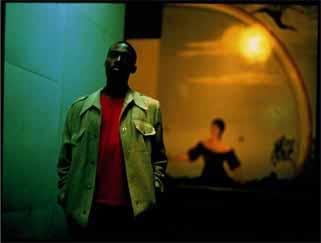Doug Aitken
dal 19/2/2001 al 13/5/2001
Segnalato da
19/2/2001
Doug Aitken
Kunstmuseum Wolfsburg, Wolfsburg
Metallic Sleep. 'The art world is constantly in competition with other media such as music, television, or film, which are far more popular, but which are mostly lacking in one crucial thing: content.' Born in California in 1968, Doug Aitken bears the formative influence of Los Angeles, the city of music and the movies, where he lives and works whenever he is not engaged on one of his lengthy journeys of exploration across the globe.

Metallic Sleep.
'The art world is constantly in competition with other media such as music,
television, or film, which are far more popular, but which are mostly lacking in
one crucial thing: content.'
Born in California in 1968, Doug Aitken bears the formative influence of Los
Angeles, the city of music and the movies, where he lives and works whenever
he is not engaged on one of his lengthy journeys of exploration across the
globe. With Douglas Gordon and Pipilotti Rist, he belongs to a new generation
of artists who have decisively enriched the medium of video. They expand the
traditional viewing space into a sculptural installation space, where multiple
planes of projection overlap, and where architectural devices and color
concepts are used to generate a total visual impression. Unmistakably, the
artists of this latest generation have grown up in an age in which the electronic
media are present in every aspect of life, round the clock. The visual language
of television is second nature to them and provides a point of reference for
their work as artists.
Doug Aitken first became known to a wider public when his prizewinning video
installation 'Electric Earth' (1999) was presented at the last Venice Biennale.
In his works, the viewer repeatedly encounters weird landscapes, 'nonplaces'
that no one would ever choose as the destination of a journey: derelict
machinery and ruined buildings on an abandoned diamond mine in the
Namibian desert in 'Diamond Sea'; urban wastelands in 'Electric Earth'. This
sizeable video installation, with eight projections, forms the central focus of
the Wolfsburg exhibition. In it, Aitken pursues the theme of the urban isolation
of individuals whose communication and interaction is confined to the
desolation of a nonplace. Deserted parking lots that acquire and lose their
(social) function according to the rhythm of store opening and closing hours:
for Aitken, who describes himself as 'always in motion,' the melancholy of
these inhospitable environments is the starting point for a visual and narrative
process of discovery. Motion, in his work, is a form through which to
communicate perceptual impressions, whether visual, musical, or linguistic.
The formal choreography of Aitken's audiovisual works makes striking use of
precisely calculated juxtapositions of motion at different speeds,
superimpositions, alternations between hard and soft focus, and shifts of scale
between the macroscopic and the microscopic. All this is accompanied by a
rhythmically articulated soundtrack, precisely adjusted to the visual language.
He makes playful use of the technological and aesthetic know-how of
commercial film and music-video production. Chronological narrative
structures, disrupted by this aesthetic of fragmentation and subdivision,
overflow onto multiple, juxtaposed projection screens. Aitken's system of
video installation confronts the viewer not only with a narrative action, the
course of which has to be followed and understood, but also with the spatial
structure of that action, in and through which he or she can move both
mentally and physically.
In addition to 'Electric Earth', the exhibition in Wolfsburg will show a sound
installation from Aitken's video piece 'Hysteria', 1998 and a number of
photographic works.
The exhibition in Wolfsburg will be complemented by a presentation of Doug
Aitken's piece 'I am In You' (2000) at Kunst-Werke in Berlin.
The Kunstmuseum Wolfsburg has already mounted a number of joint projects
with organizations in Berlin, and so it was an attractive idea to make the Berlin
public aware of the Wolfsburg show by simultaneously presenting one of
Aitken's works there. 'I am In You' (2000) has already been seen in Zurich as
a fragment; at Kunst-Werke it will have its first showing in its final form.
Kunst-Werke Berlin
18.02. - 08.04.2001
Auguststrasse 69, 10117 Berlin
phone (030)2434590, fax (030)24345999
opening hours: Tuesday to Sunday 12 a.m. - 6 p.m.
Closed Monday.
E-Mail: office@kw-berlin.de; http://www.kw-berlin.de
A catalogue, designed by Doug Aitken, with texts by Francesco Bonami, Jörg
Heiser, Gijs van Tuyl and Veit Görner, will accompany the exhibition. App.
120 pages, illustrated throughout, format 30 x 26 cm, text in German and
English.
Image: ELECTRIC EARTH , 1999, Video Still
Kunstmuseum Wolfsburg, Porschestrasse 53, 38440 Wolfsburg, Germany
Phone: +49.5361.26690 Fax: +49.5361.266966
Opening hours
Wednesday to Sunday: 11 a.m - 6 p.m.;
Tuesday: 11 a.m - 8 p.m.
Closed on Monday
Admission: DM 12,-;
Concessions: DM 8,-;
Family ticket: DM 25,-;
Annual ticket: DM 60,-;
Groups of 12 or more: DM 8,- per person:
School parties: free
Guided tours in English + French: +49.5361.266920



